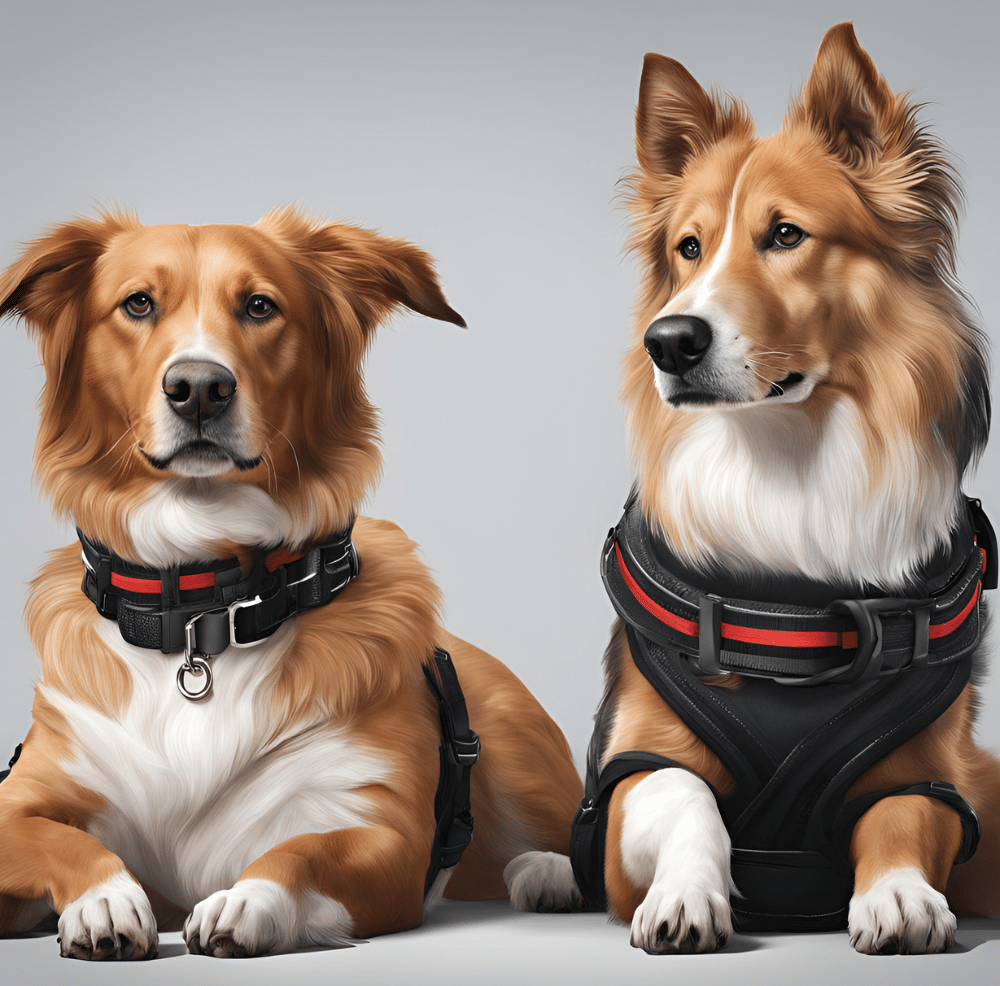Dog Harness vs. Collar: Expert Reveals Hidden Dangers You Need to Know!
Choosing between a dog harness vs. collar isn't just about aesthetics; it's a decision that profoundly impacts your dog's safety, comfort, and training. Imagine walking your furry friend, the leash suddenly yanking, and the pressure tightening around their neck. Is that pressure distributed across their chest with a harness, or focused solely on their throat with a collar? This guide dives deep into the hidden dangers and surprising benefits of each, arming you with the knowledge to make the best choice for your beloved companion.
Understanding Dog Collars: Types and Uses
Dog collars have been a staple in pet ownership for decades, serving multiple purposes beyond just holding an ID tag. Let's explore the common types:
- Flat Collars: The most common type, ideal for everyday use with an ID tag and leash attachment.
- Martingale Collars (Limited Slip): Designed for dogs with slender necks, like Greyhounds, preventing them from slipping out.
- Buckle Collars: Similar to belts, offering adjustability and secure closure.
- Prong Collars: Used for training, applying pressure around the neck to discourage pulling (use with extreme caution and professional guidance).
- Electronic Collars (E-Collars): Remote-controlled collars delivering a static correction; controversial due to potential for misuse and stress.
Exploring Dog Harnesses: A Variety for Every Pup
Dog harnesses have surged in popularity, offering a different approach to leash control. Here's a look at the common styles:
- Back-Clip Harnesses: The leash attaches to the dog's back, suitable for well-behaved dogs on leisurely walks.
- Front-Clip Harnesses: Designed to discourage pulling; when the dog pulls, they are redirected to face you.
- Dual-Clip Harnesses: Offer both back and front leash attachment options for versatility.
- Step-In Harnesses: The dog steps into the harness, which is then buckled around their body, ideal for dogs who dislike having things pulled over their head.
- Vest Harnesses: Provide more coverage and support, often padded for comfort, and may have pockets or pouches.
Dog Collars: Weighing the Pros and Cons
Dog collars offer certain advantages but also come with potential drawbacks:
Pros of Dog Collars:
- Convenience: Easy to put on and take off.
- ID Tag Attachment: Ideal for displaying identification and contact information.
- Cost-Effective: Typically less expensive than harnesses.
Cons of Dog Collars:
- Risk of Injury: Can cause neck injuries, especially with pulling or sudden jerks.
- Tracheal Damage: Constant pressure can lead to tracheal collapse over time.
- Escape Risk: Dogs can slip out of collars, particularly if not fitted properly.
Dog Harnesses: Weighing the Pros and Cons
Dog harnesses offer distinct advantages but also have potential downsides:
Pros of Dog Harnesses:
- Reduced Neck Strain: Distributes pressure across the chest and shoulders, minimizing neck injury risk.
- Better Control: Offers more control, especially for strong or reactive dogs.
- Safer for Certain Breeds: Recommended for brachycephalic (short-nosed) breeds prone to respiratory issues.
Cons of Dog Harnesses:
- Potential for Tangling: Leashes can become tangled in the harness straps.
- Fit Issues: Requires careful fitting to avoid chafing or discomfort.
- Can Encourage Pulling (Back-Clip): Some harnesses (back-clip) can inadvertently encourage pulling if not used correctly with training.
Safety First: Dog Harness vs. Collar – Which is Safer?
Generally, a harness is considered safer than a collar, especially for dogs prone to pulling or those with pre-existing neck or respiratory issues. Harnesses distribute pressure more evenly, reducing the risk of injury. However, safety also depends on proper fit, training, and responsible leash handling.
The Hidden Dangers of Dog Collars: What You Need to Know
While collars seem harmless, they can pose hidden dangers:
- Tracheal Collapse: Repeated pressure on the trachea can weaken it over time, leading to collapse and breathing difficulties.
- Glaucoma Risk: Pulling on the leash can increase pressure in the eyes, exacerbating glaucoma in predisposed dogs.
- Neurological Damage: Pressure on the neck can damage nerves, leading to pain or neurological issues.
- Behavioral Problems: Pain or discomfort from collar pressure can lead to reactivity or aggression.
The Hidden Dangers of Dog Harnesses: What to Watch Out For
Harnesses are generally safer but aren't without potential issues:
- Chafing: Ill-fitting harnesses can rub against the skin, causing chafing and irritation.
- Skin Irritation: Material sensitivities can lead to allergic reactions or skin irritation.
- Mobility Restriction: Some harnesses can restrict shoulder movement, especially for active dogs.
- Encouraging Pulling: Back-clip harnesses, if not used with training, can inadvertently encourage pulling.
Perfect Fit: How to Properly Fit a Dog Collar
A properly fitted collar is crucial for safety and comfort:
- Measure: Measure your dog's neck circumference with a flexible measuring tape.
- Two-Finger Rule: You should be able to comfortably fit two fingers between the collar and your dog's neck.
- Check for Slippage: Ensure the collar cannot be easily slipped over your dog's head.
- Adjust as Needed: Regularly check the fit, especially for puppies who are growing.
The Right Fit: How to Properly Fit a Dog Harness
A well-fitted harness is essential for comfort and effectiveness:
- Measure: Measure your dog's chest circumference and neck size.
- Refer to Size Chart: Consult the manufacturer's size chart, as sizes vary between brands.
- Snug but Not Tight: The harness should be snug but not restrict movement. You should be able to fit a few fingers between the harness and your dog's body.
- Adjustable Straps: Use adjustable straps to customize the fit.
- Test the Fit: Observe your dog's movement and look for signs of chafing or discomfort.
Making the Right Choice: Key Factors to Consider
Several factors influence the best choice for your dog:
- Dog Breed: Brachycephalic breeds benefit from harnesses, while slender-necked breeds need specialized collars.
- Dog Size: Small dogs are more susceptible to neck injuries from collars, making harnesses a safer option.
- Dog Age: Puppies need adjustable collars or harnesses to accommodate growth. Senior dogs may benefit from padded harnesses for comfort.
- Dog Temperament: Dogs who pull benefit from front-clip harnesses. Well-behaved dogs can use flat collars.
Situation Matters: When to Choose a Harness over a Collar (and Vice Versa)
Consider these scenarios:
- Training: Front-clip harnesses are ideal for leash training and discouraging pulling.
- Walking: Harnesses are generally safer for walks, especially in crowded areas.
- Car Rides: Harnesses can be used with seatbelts for safer car travel.
- Quick Identification: Collars are useful for displaying ID tags at all times.
- Swimming: Collars are preferable for swimming, as harnesses can restrict movement in the water.
Expert Advice: Veterinarian and Dog Trainer Recommendations
Veterinarians often recommend harnesses to prevent neck injuries, especially for breeds prone to tracheal collapse or glaucoma. Dog trainers typically advocate for front-clip harnesses during leash training to discourage pulling and improve control.
Beyond Collars and Harnesses: Exploring Alternatives
Consider these alternatives:
- Head Halters (Gentle Leaders): Provide control by guiding the dog's head, but require careful introduction and training.
- Service Dog Vests: Primarily for service dogs, but can provide a sense of security and purpose for some dogs.
Maintenance Matters: When to Replace Your Dog's Collar or Harness
Regularly inspect your dog's collar or harness for wear and tear. Replace it if you notice:
- Fraying or Tears: Weakened straps can break during walks.
- Broken Buckles or Clasps: Compromised closures can lead to escapes.
- Fading or Discoloration: Indicates material degradation from sun exposure.
- Poor Fit: If your dog has outgrown the collar or harness, it's time for a replacement.
The decision between a dog harness vs. collar is a personal one, deeply intertwined with your dog's unique needs and your lifestyle. Remember, knowledge is your greatest tool. Understand the benefits and risks, consider your dog's breed, size, temperament, and specific situations, and consult with experts. By making an informed choice, you're not just buying a piece of equipment; you're actively contributing to your dog's safety, comfort, and overall well-being. It's about creating joyful, worry-free walks and strengthening the unbreakable bond you share. Learn even more with mastering dog obedience training guide


